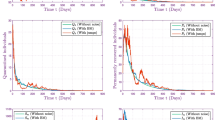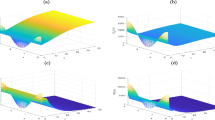Abstract
In the context of mathematical epidemiology, the type-reproduction number (TRN) for a specific host type is interpreted as the average number of secondary cases of that type produced by the primary cases of the same host type during the entire course of infection. Here, it must be noted that T takes into account not only the secondary cases directly transmitted from the specific host but also the cases indirectly transmitted by way of other types, who were infected from the primary cases of the specific host with no intermediate cases of the target host. Roberts and Heesterbeek (Proc R Soc Lond B 270:1359–1364, 2003) have shown that T is a useful measure when a particular single host type is targeted in the disease control effort in a community with various types of host, based on the fact that the sign relation sign(R 0 − 1) = sign(T − 1) holds between the basic reproduction number R 0 and T. In fact, T can be seen as an extension of R 0 in a sense that the threshold condition of the total population growth can be formulated by the reproduction process of the target type only. However, the original formulation is limited to populations with discrete state space in constant environments. In this paper, based on a new perspective of R 0 in heterogeneous environments (Inaba in J Math Biol 2011), we give a general definition of the TRN for continuously structured populations in heterogeneous environments and show some examples of its computation and applications.
Similar content being viewed by others
References
Agur Z, Cojocaru L, Mazor G, Anderson RM, Danon YL (1993) Pulse mass measles vaccination across age cohorts. Proc Natl Acad Sci USA 90: 11698–11702
Bacaër N, Guernaoui S (2006) The epidemic threshold of vector-borne diseases with seasonality. J Math Biol 53: 421–436
Bacaër N (2007) Approximation of the basic reproduction number R 0 for vector-borne diseases with a periodic vector population. Bull Math Biol 69: 1067–1091
Bacaër N (2009) Periodic matrix population models: growth rate, basic reproduction number, and entropy. Bull Math Biol 71: 1781–1792
Bacaër N, Ait Dads EH (2011a) Genealogy with seasonality, the basic reproduction number, and the influenza pandemic. J Math Biol 62: 741–762
Bacaër N (2011b) The model of Kermack and McKendrick for the plague epidemic in Bombay and the type reproduction number with seasonality. J Math Biol. doi:10.1007/s00285-011-0417-5
Bacaër N, Ait Dads EH (2011c) On the biological interpretation of a definition for the parameter R 0 in periodic population models. J Math Biol. doi:10.1007/s00285-011-0479-4
Diekmann O, Heesterbeek JAP, Metz JAJ (1990) On the definition and the computation of the basic reproduction ratio R 0 in models for infectious diseases in heterogeneous populations. J Math Biol 28: 365–382
Diekmann O, Heesterbeek JAP, Roberts MG (2010) The construction of next-generation matrices for compartmental epidemic models. J R Soc Interface 6 7(47):873–885
Grassly NC, Fraser C (2006) Seasonal infectious disease epidemiology. Proc R Soc B 273: 2541–2550
Heesterbeek JAP, Roberts MG (2007) The type-reproduction number T in models for infectious disease control. Math Biosci 206: 3–10
Heffernan JM, Smith RJ, Wahl LM (2005) Perspectives on the basic reproductive ratio. J R Soc Interface 2: 281–293
Iannelli M (1995) Mathematical Theory of Age-Structured Population Dynamics. Giardini Editori e Stampatori in Pisa
Inaba H (2006) Mathematical analysis of an age-structured SIR epidemic model with vertical transmission. Discret Contin Dyn Syst Series B 6(1): 69–96
Inaba H, Nishiura H (2008a) The basic reproduction number of an infectious disease in a stable population: The impact of population growth rate on the eradication threshold. Math Model Nat Phenom 3(7): 194–228
Inaba H, Nishiura H (2008b) The state-reproduction number for a multistate class age structured epidemic system and its application to the asymptomatic transmission model. Math Biosci 216: 77–89
Inaba H (2010) The net reproduction rate and the type-reproduction number in multiregional demography. In: Vienna Yearbook of Population Research 2009, pp 197–215
Inaba H (2011) On a new perspective of the basic reproduction number in heterogeneous environments. J Math Biol. doi:10.1007/s00285-011-0463-z
Inaba H (2012) The Malthusian parameter and R 0 for heterogeneous populations in periodic environments. Math Biosci Eng 9(2): 313–346
Li CK, Schneider H (2002) Applications of Perron-Frobenius theory to population dynamics. J Math Biol 44: 450–462
Li J, Blakeley D, Smith RJ (2011) The failure of R 0. Comput Math Methods Med. 2011:Article ID 527610
Marek I (1970) Frobenius theory of positive operators: comparison theorems and applications. SIAM J Appl Math 19: 607–628
Metz JAJ, Diekmann O (eds) (1986) The Dynamics of Physiologically Structured Populations. Lecture Notes in Biomathematics, vol 68. Springer, Berlin
Nokes DJ, Swinton J (1995) The control of childhood viral infections by pulse vaccination. IMA J Math Appl Med Biol 12: 29–53
Nokes DJ, Swinton J (1997) Vaccination in pulses: a strategy for global eradication of measles and polio?. Trends Microbiol 5(1): 14–19
Roberts MG, Heesterbeek JAP (2003) A new method for estimating the effort required to control an infectious disease. Proc R Soc Lond B 270: 1359–1364
Roberts MG (2007) The pluses and minuses of R 0. J R Soc Interface 4: 949–961
Schaefer HH, Wolff MP (1999) Topological Vector Spaces, 2nd edn. Springer, New York
Shulgin B, Stone L, Agur Z (1998) Pulse vaccination strategy in the SIR epidemic model. Bull Math Biol 60: 1123–1148
Thieme HR (1990) Semiflows generated by Lipschitz perturbations of non-densely defined operators. Differ Integr Equ 3(6): 1035–1066
Thieme HR (2003) Mathematics in Population Biology. Princeton University Press, Princeton
Thieme HR (2009) Spectral bound and reproduction number for infinite-dimensional population structure and time heterogeneity. SIAM J Appl Math 70(1): 188–211
van den Berg F, Bacaër N, Metz JAJ, Lannou C, van den Bosch F (2011) Periodic host absence can select for higher or lower prasite transmission rates. Evol Ecol 25: 121–137
Wang W, Zhao XQ (2008) Threshold dynamics for compartmental epidemic models in periodic environments. J Dyn Differ Equ 20: 699–717
Author information
Authors and Affiliations
Corresponding author
Rights and permissions
About this article
Cite this article
Inaba, H. On the definition and the computation of the type-reproduction number T for structured populations in heterogeneous environments. J. Math. Biol. 66, 1065–1097 (2013). https://doi.org/10.1007/s00285-012-0522-0
Received:
Revised:
Published:
Issue Date:
DOI: https://doi.org/10.1007/s00285-012-0522-0
Keywords
- Type-reproduction number
- Basic reproduction number
- Control relation
- Generation evolution operator
- Critical coverage of immunization




